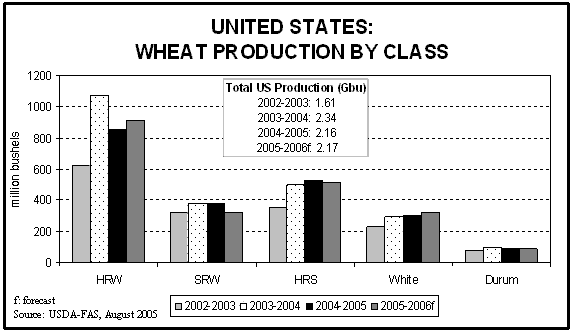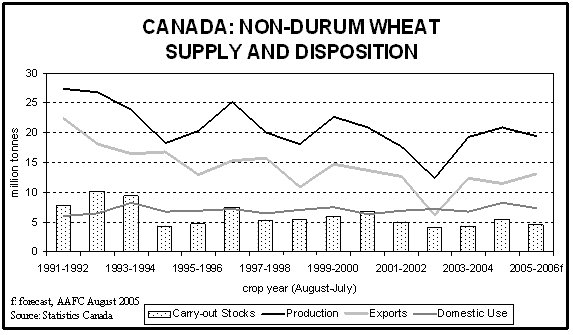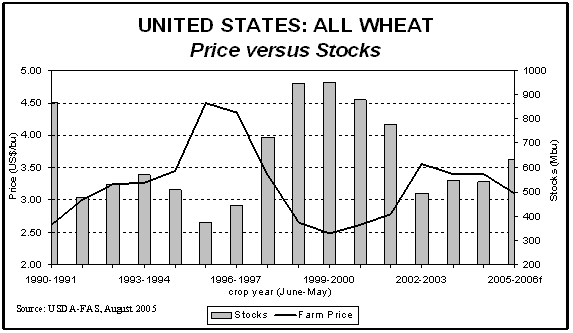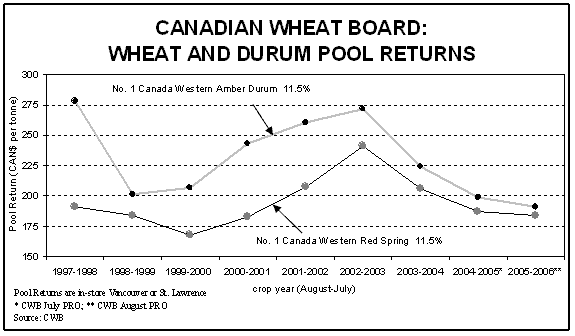Publications: Bi-weekly Bulletin
2005-09-02 | Volume 18 Number 15 | ISSN 1494-1805 | AAFC No. 2081/E
Wheat: Situation and Outlook
For 2005-2006, prices for most classes of wheat are expected to decline from 2004-2005 largely due to increased supplies in the five major exporting countries and lower import demand. The strong Canadian dollar will continue to dampen returns to Canadian farmers. This issue of the Bi-weekly Bulletin examines the situation and outlook for wheat for 2005-2006. "Wheat" refers to all wheat including durum, unless otherwise specified.
World wheat supplies for 2005-2006 are forecast by the United States Department of Agriculture (USDA) to increase slightly from 2004-2005. Higher carry-in stocks are expected to more-than offset lower production of 610 Mt, a 2% decline from last year. Wheat consumption is forecast to increase, mainly due to higher feed use in the European Union (EU) and the Former Soviet Union (FSU). World wheat carry-out stocks are expected to decline by 5%, to 141 Mt and the stock-to-use (S/U) ratio is forecast to be near the record low of 22% recorded in 2003-2004. Trade is expected to decline by 3%, to 108 Mt, mainly due to reduced imports by China. Of the total exports, the US is expected to account for 25%, with Canada, Australia, the EU-25 and FSU each contributing about 15%.
Non-durum wheat production is down only slightly, to 575 Mt and trade is forecast to decline by 4% to 101 Mt, close to the 10-year average.
Durum wheat production is estimated by the International Grains Council (IGC) at 35.5 Mt, 14% lower than last year. Trade is forecast to rise by 15%, to a record 7.8 Mt.
United States
All wheat production is estimated by USDA at 2,170 million bushels (Mbu) (59.0 Mt), only marginally above 2004-2005. Increased production of hard red winter (HRW), white wheat and durum is expected to more-than offset reduced output of soft red winter, (SRW) and hard red spring (HRS) wheat. Total US wheat exports are forecast to decrease by 8%, to 975 Mbu due to increased competition from the EU and the FSU. As a result of lower exports, carry-out stocks and the stocks-to-use ratio are expected to increase from 2004-2005. US wheat imports, largely from Canada, are forecast at 70 Mbu (including products), similar to 2004-2005, and 14% below the 10-year average. Non-durum wheat imports will be mainly Ontario winter wheat, due to the continuing duties on imports of Canadian HRS wheat.
SRW wheat production is expected to decrease by almost 16% from last year while HRW production increases by 9% and HRS production decreases marginally. However, stocks are expected to rise for all classes of wheat, pressuring wheat prices in general. For high quality milling wheat, prices are expected to be further pressured by improved spring wheat quality in western Canada.
For durum, production is forecast to rise by 4%, to 93 Mbu, marginally above the 5-year average.
The national loan rate under the US Security and Rural Investment Act (FSRIA) for wheat for 2005-2006 is US$2.75 /bu. There are individual loan rates by class of wheat. The target price, which determines the counter-cyclical payment (CCP) is US$3.86 /bu for wheat and exceeds both the loan rate and expected actual farm price. The target price is not county-specific. The CCP is determined by the target price minus the fixed payment (US$0.25 /bu) minus the higher of the loan rate or the average farm price. The CCP is based on 85% of a farmer's base area and yields, and is decoupled from a farmer's actual seeded area.
European Union-25
Although exports increased by 24% in 2004-2005, aided by an average subsidy of US$8 per tonne (/t), carry-out stocks, consisting largely of lower quality wheat, nearly tripled to a record 26.0 Mt. As a consequence, EU domestic supplies are forecast to rise by 3%. Production is forecast to decrease by 8% from 2004-2005 to 125.5 Mt, the second-highest on record, versus the 5-year average of 121 Mt. Exports are projected to rise by 11%, aided by continued use of export subsidies. In the first week of February, 2005, EU resumed the weekly open market export tenders, after suspending them for the previous 18 months due to burdensome stocks and the appreciation of the Euro against the US dollar. EU domestic consumption is also forecast to increase due to higher feed use, and carry-out stocks are expected to decrease but remain burdensome.
Durum wheat accounts for 8-10% of total EU wheat production and about 98% is from Italy, Spain, France and Greece, along the Mediterranean Sea. EU production is estimated by IGC to decrease by 36% from 2004-2005 to 7.3 Mt due to a drought in Spain and in Italy, as a result of Common Agricultural Policy Reform, a reduction in seeded area. Imports are projected to rise by 44% to a record 2.3 Mt. Canadian durum exports to the EU are expected to rise significantly from the 0.3 Mt in 2004-2005. EU carry-out stocks are forecast to fall significantly to a well-below normal level.
Australia
Australia had one of the driest autumns (March-May) on record but precipitation during June improved moisture conditions at seeding time. Wheat production is forecast by the USDA at 21.5 Mt, unchanged from last year. Exports are projected to decrease marginally, to 15.5 Mt (July-June), close to the 5-year average. Carry-out stocks are forecast to remain relatively unchanged at 5.9 Mt.
Australian durum production is forecast by the IGC at 0.5 Mt, the same as 2004-2005. Below average yields are expected again this season because of continued drought in parts of Australia and the relatively late seeding this season. Australian durum tends to be of good quality due to the hot dry growing conditions, and Australia has become a major competitor in the premium Italian market. Exports are forecast by IGC to rise by 25% in 2005-2006, to 0.5 Mt.
Argentina
For the 2005-2006 wheat planting season, Argentina has been dry, particularly in the key wheat producing province of Buenos Aires, and as a result, both area and yields are expected to decline from 2004-2005. Production and exports are forecast to decrease significantly from 2004-2005 to 13.5 Mt and 8.0 Mt (July-June), respectively.
Argentine durum is mainly grown in the southern part of the province of Buenos Aires. Area seeded is expected to decrease as farmers switch to more profitable crops, primarily sunflowers and soybeans. Yields are expected to increase and production is forecast at 0.2 Mt, similar to 2004-2005.
Former Soviet Union
The FSU recovered from the severe winterkill of 2003-2004, with production increasing sharply, particularly in Russia and Wheat: Situation and Outlook, in 2004-2005. For 2005-2006, production is forecast at 77 Mt, up 6% from last year. Supplies are expected to increase by 9%.
Consumption is forecast to increase to the highest level since 1997-1998 due to increased feed use. Exports are projected to rise by 27%, to 18.5 Mt, second only to the record 25.4 Mt exported in 2002-2003. Carry-out stocks are forecast to increase marginally.
India
Wheat production in India is supported by high internal guaranteed prices, and has been steadily increasing due to improved yields. Indian wheat tends to be of lower quality, and much has been exported as feed into Southeast Asia. Exports were a record 5.7 Mt in 2003-2004. Indian wheat does not compete directly with Canadian wheat in any market. Consumption has exceeded production since 2002-2003. Wheat production is forecast to be the same as last year at 72.0 Mt, 1 Mt lower than projected consumption. India is forecast to be a net wheat importer in 2005-2006, for the first time since 1999-2000, importing 1.0 Mt, versus exports of 0.5 Mt which are the lowest in 6 years. Carry-out stocks are expected to fall to 3.6 Mt.
For durum, production is forecast by IGC at 2.0 Mt, unchanged from 2004-2005. Most of it is used domestically.
China
Excluding the EU-25, China is the world's largest wheat producer, with production averaging 92 Mt over the past 5 years. Due to lower government support, area seeded to wheat has decreased by 28% since 1997-1998. This has largely affected the production of lower quality wheat as the emphasis shifted to producing higher quality varieties. As a result, Chinese wheat production and supplies fell and China began to import wheat in 2003-2004, with imports reaching 7 Mt in 2004-2005, the highest in a decade.
For 2005-2006, production is forecast to increase by 4% to 95 Mt but due to lower carry-in stocks, supplies are projected to fall marginally. However, Chinese wheat consumption levels have steadily declined since 2000-2001, as consumers have diversified their diets to include more meat, fruits and vegetables. For 2005-2006, consumption is forecast at 101 Mt, the lowest since 1987-88. Imports are forecast to decrease to 3 Mt of which 1.5 Mt are expected to be sourced from Canada, versus 2.1 Mt in 2004-2005.
Middle East
Middle Eastern wheat production is forecast to decrease marginally from 2004-2005 causing imports to increase. The major Canadian market in this region was Iran, which has imported large quantities of wheat in previous years. However, wheat production in Iran is forecast to increase to a record level leading to a decrease in wheat imports. Canada is not expected to export wheat to Iran in 2005-2006, as was also the case in 2004-2005.
Syria and Turkey are the major durum producers in the Middle East. For 2005-2006, Syrian durum production is expected to remain unchanged, at 2.5 Mt. Exports are forecast by IGC to rise by 45%, to a record 0.8 Mt. Turkish production is also expected to remain unchanged, at 3.2 Mt. Exports are forecast to double from 2004-2005, to 0.2 Mt.
North Africa
The North African countries, particularly Algeria, Morocco, Tunisia and Libya, are important to Canada as they make up the largest single world market for durum wheat. North Africa is also a major market for non-durum wheat, but not for Canadian wheat, sourcing most of their soft wheat imports from the EU and US.
For 2005-2006 North African wheat production is expected to decrease due to a drought in Morocco and Algeria. Total wheat production is forecast to fall by 25%, at 12.4 Mt. Durum production is expected to decrease by 29%, to 3.8 Mt, due to reduced harvested area and lower yields, but remain above the 10-year average of 3.5 Mt. As a result, total imports are forecast by the USDA to increase by 6%, to 18.6 Mt. Durum imports by Algeria, Morocco, Tunisia and Libya are forecast by IGC to rise by 24%, to 3.1 Mt. Durum exports from Canada to North Africa are projected to increase significantly to about 1.5 Mt from 1.0 Mt in 2004-2005.
Canada
For non-durum wheat, 2005-2006 seeded area declined slightly, to 7.7 million hectares (Mha). In addition to this decline, abandonment is expected to be historically high for the second consecutive year due to excessive rain in Manitoba. A decrease of 3% in the harvested area estimates by Statistics Canada (SC) reflect those expectations. Despite poor yields in much of Manitoba, good moisture in the remainder of the Prairies is expected to result in average yields just 4% below last year record, at 2.61 tonnes per hectare (t/ha) {38.8 bushels per acre (bu/ac}, about 4 bu/ac above the 10-year average. Production is estimated by SC at 19.6 Mt, 6% below 2004-2005.
Assuming normal harvest weather, the quality of the crop in western Canada is expected to be much better than in 2004-2005, when one of the poorest quality crops on record was harvested due to premature frost and wet harvest conditions. However, protein content is negatively correlated with yields, so that protein levels may be below normal. In Ontario, production is forecast to decline by 5% to 1.6 Mt, but with good quality reported.
Carry-in stocks have risen by 28%, partially offsetting the lower production. Supplies are projected to be only marginally lower than for 2004-2005. However, these stocks are largely of poor quality wheat, which is expected to result in above-normal wheat feeding for the second year in a row. Exports are forecast to increase by 16%, to 13.2 Mt, due to increased supplies of good quality wheat. Carry-out stocks are projected to fall by 18% to a historically low 4.5 Mt, due to improved crop quality and strong export demand.
For durum wheat, 2005-2006 area seeded is similar to last year at 2.3 Mha, with reduced levels of abandonment resulting in a 4% increase in harvested area. The good moisture and heat this summer has increased durum yield potential, and the average yield is estimated at a well above average 2.28 t/ha (33.9 bu/ac), just marginally lower than in 2004-2005. As a result, production is estimated to increase by 2%, to 5.1 Mt, the highest since 2000-2001.
As with non-durum wheat, quality is expected to be much better than last year, but potentially below normal, due to the wet growing conditions. As well, protein levels may be below average.
Carry-in stocks are up by 48%, at a record 2.7 Mt, with most expected to be of lower grades. Supplies are projected to increase by 15%, to a record 7.8 Mt, well above the 10-year average of 6.3 Mt. Exports are projected to rise by 16%, to 3.6 Mt, due to increased supplies, particularly of the top milling grades, and improved world demand, particularly in the EU and North Africa. However, durum demand is inelastic as there are few uses for the crop other than for pasta or couscous, and it is unlikely that all Canadian supplies in 2005-2006 can be exported or consumed domestically. Therefore, carry-out stocks are expected to rise for the fourth consecutive year, to a record 3.2 Mt, well above the 10-year average of 1.8 Mt.
Price Outlook
World
For 2005-2006, wheat prices are expected to generally decrease from 2004-2005. Pressure from higher carry-out stocks in the US is expected to more-than offset support from lower production and carry-out stocks at the world level. As the major wheat futures markets are located in the US, and since the US is a major producer and exporter of wheat, the US market has a disproportionate impact on world wheat prices. Global import demand is expected to decrease which also pressures prices downward.
Agriculture and Agri-Food Canada forecasts that world prices, as measured by the benchmark US Hard Winter Ordinary (HWO) price, FOB Gulf ports, which is determined largely by the KCBT futures market, will decrease to US$140-$150 /t for 2005-2006 from US$154 /t in 2004-2005 (August-July).
United States
Average US wheat prices are expected to decline due to higher US carry-out stocks, which are negatively correlated with the average US farm price. However, the price changes will vary by class of wheat, due to different supply and disposition factors.
The supply of US SRW wheat, as estimated by the USDA, is expected to decrease by about 9% as lower production more-than offsets higher carry-in stocks. SRW prices on the CBoT are expected to average US$3.10-3.15 /bu versus US$3.18 /bu for 2004-2005.
The supply of US HRW wheat is estimated to increase by 5% from 2004-2005 as higher US production more-than offsets lower carry-in stocks. Production is estimated at 913 Mbu, up by 7% 2004-2005. The S/U ratio is forecast to rise from 22% in 2004-2005 to 25% in 2005-2006. The premium for HRW over SRW is expected to decrease to about US$0.15 /bu, versus US$0.24 /bu in 2004-2005, and the 10-year average of US$0.22 /bu. The average nearby KCBT HRW price is forecast to decrease by about 5%, to US$3.25-$3.35 /bu (June-May).
The supply of US HRS wheat is estimated to decrease marginally as lower production more-than offsets higher carry-in stocks. US production is estimated to fall by 2%, to 516 Mbu. Due to increased competition from other exporters, including Canada, exports are forecast to fall by 13%, to 270 Mbu. Carry-out stocks are projected to increase by 6%, to 169 Mbu, with the S/U ratio rising to 33%, from 30% last year. The premium over the KCBT is expected to return to a normal level of US$0.20 /bu, from US$0.14 /bu in 2004-2005, so that the average nearby futures price on the Minneapolis Grain Exchange (MGE) is forecast to be relatively unchanged from 2004-2005, at US$3.55-$3.60 /bu.
However, assuming better quality and improved protein content in both the US and Canadian HRS crops, premiums for top quality high protein Dark Northern Spring (DNS) wheat are expected to decline, with the cash premium for DNS with 14% protein (DNS 14) at Minneapolis forecast to fall by over 30%, to a slightly above-normal US$0.70 /bu, with the average DNS 14 cash price being US$4.25-4.30 /bu, 7% below 2004-2005.
The supply of US durum wheat is estimated to increase by 10% from 2004-2005 due to higher carry-in stocks and production. Production is forecast to rise by 3% to 93 Mbu.
In addition, world durum prices are also expected to be pressured by burdensome Canadian supplies. The US No.3 Hard Amber Durum (HAD) export price FOB Gulf is expected to decrease from US$193 /t in 2004-2005 to US$175 /t in 2005-2006 (June- May).
Canada
In most quality-conscious markets, the Canadian Wheat Board (CWB) normally receives a price for wheat and durum that is competitive with US prices for wheat of similar quality. The prices obtained by the CWB are therefore, to a large degree, impacted by US crop conditions, domestic consumption and exports.
CWB returns are expected to be similar to 2004-2005 for lower quality spring wheat (low protein No.2 CWRS, No.3 CWRS and CPS), due to the expected flat MGE HRS futures market. However, projected declining premiums for DNS 14 will result in lower returns for higher protein Nos. 1 and 2 CWRS wheat. Canadian durum prices are forecast to decline, in line with lower world and US prices.
Grain is traded on world markets in US dollars, and a stronger Canadian dollar reduces returns in Canadian dollar terms. For 2005-2006, the dollar is forecast to be only marginally stronger at about US$0.81, versus US$0.795 for 2004-2005, so that the dollar will not have a major impact on the year-over-year change in returns.
The CWB initial payments for 2005-2006 are significantly lower than those set at the beginning of the 2004-2005 crop year, particularly for non-durum wheat. The reason for the disproportionate decline in initial payments for non-durum wheat, compared to the pool return outlook (PRO), is that the PRO was much stronger at the beginning of the 2004-2005 crop year. For example, the PRO for No.1 CWRS 12.5 in July 2004 was $214 /t, $20 /t higher than currently projected and $24 /t above the current outlook for 2005-2006.
The July 2004 PRO turned out to be overly optimistic mainly due to the larger than expected 2004-2005 world wheat crop and resultant higher than projected carry-out stocks. The stronger than expected Canadian dollar also eroded CWB pool returns in 2004-2005. August 1, 2004 the dollar was worth US$0.76, and was expected to remain near that level for the crop year, while it actually averaged about US$0.80. Similarly, the current 2005-2006 PRO could be raised or lowered later in the year, as more complete information on supply and disposition factors and actual market prices becomes available.
Once the CWB has made significant sales at prices above the original initial payment level, the sales revenue offsets part of the federal government guarantee and the initial payments may be adjusted upwards. The safety factor applies only to the unsold portion of the pool account. These adjustments will occur earlier in the crop year if the price outlook strengthens, but will in most cases be made eventually as long as the price outlook does not decline significantly. For 2004-2005, the initial payment for No.1 CWRS 12.5 was adjusted to $177.10 /t by the end of the crop year, $27.10 /t higher than at the beginning, despite the declining price outlook throughout the year.
- Canada-US Wheat Trade Dispute
- September 13, 2002
- The North Dakota Wheat Commission and US Durum Growers launched a petition asking the US government to initiate countervailing duty and anti-dumping investigations against Canadian HRS wheat and durum imports. They alleged that the Canadian government unfairly subsidized Canadian wheat and that the CWB "dumps" wheat into the US at below market prices.
- March 4, 2003
- Tariffs on Canadian imports to the US of 3.94% on HRS wheat and durum were announced pursuant to the countervailing duty case. This preliminary determination was a US domestic trade action, carried out under US trade law and investigated by the US Department of Commerce (DOC), which also makes the final determinations. The US International Trade Commission (ITC) is also investigating whether injury had been caused to the US wheat industry.
- May 2, 2003
- Based on preliminary findings that Canada was dumping wheat into the US at below market prices, the US DOC imposed preliminary anti-dumping duties of 6.12% on HRS wheat and 8.15% on durum, in addition to the 3.94% duties imposed by the US in March over subsidy allegations.
- August 29, 2003
- The US DOC increased combined tariffs on Canadian HRS wheat and durum exports to the US to 14.15% and 13.55%, respectively, in its final determination.
- October 3, 2003
- The US ITC determined that imports of durum wheat were not injuring US producers but that imports of HRS wheat were injuring the US wheat sector. Thus the existing tariffs on HRS wheat remain but were removed for durum.
- March 10, 2004
- A North American Free Trade Agreement (NAFTA) panel ordered the US DOC to reconsider duties on spring wheat imports from Canada. Panellists decisively rejected the US DOC treatment of the three guarantees as a single program under the heading of inancial risk coverage and required that each guarantee to be separately evaluated. The panel reaffirmed the US DOC decision to assess a 0.35% duty resulting from government provision of railcars.
- June 7, 2005
- A NAFTA panel said it could find "no substantial evidence" to support the injury allegations. The US Panel noted that the US ITC had failed to prove causation between imports of Canadian wheat and circumstances in the US wheat industry. The US ITC is expected to respond to the Panel on October 5, 2005.
- August 8, 2005
- The US DOC lowered the level of countervailing duties on imports of Canadian wheat to 2.54% from 5.29% in response to an order by a NAFTA panel. An 11.4% combined tariff still remains on HRS wheat.
by
While the Market Analysis Division assumes responsibility for all information contained in this bulletin, we wish to gratefully acknowledge input from the following: Canadian Wheat Board, Market and Industry Services Branch (AAFC)
|
|
||
| Date Modified: 2006-12-08 |
|
|
|
[ Français | Contact Us | Help | Search | Canada Site ] [ AAFC Online | Links | Newsroom | What's New | Site Index ] |
||







